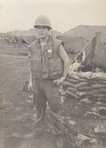Thus it begins.
I will begin this blog with something that many people know - unless they are a movie writer or producer.
Certainly anyone reading this blog has seen at least a few Hollywood costumers about Rome. And all of those movies, if they have anything military at all, will have the soldiers saluting their superiors with the official gesture of the Roman military. That is, holding the elbow level with the shoulder, then bringing the forearm to the chest before extending it straight to the front.
It is very dramatic and quite martial. Unfortunately, it is also without any known historical foundation. It has been copied innumerable times – by the Nazis, the Fascists – even the Americans with the Bellamy salute from the 1800’s. Certainly the Legionaries used some sort of salute, but no historical documents, paintings or statuary support our accepted version of that time. I doubt that the actual gesture would have been so dramatic.
Salutes in the military are used for respect – to a superior, the flag, an honorable deed – but the original purpose, and by far the most important, is for an officer to know that his order has been heard and received. Many a command has been lost in the clamor of an engagement, or later, under the boom of gunfire – the failure of delivery unnoticed by the commander. Often the result is a missed opportunity or even a lost battle. A salute is the non-verbal reply over the chaos, of Aye Aye, Yes Sir, Roger or Wilco. And I suspect that the Roman gesture, as given in the movies, is far too complicated to be used in the heat of battle. Probably, it was a simple raising of the flat hand to the head, just as is used today.
Certainly anyone reading this blog has seen at least a few Hollywood costumers about Rome. And all of those movies, if they have anything military at all, will have the soldiers saluting their superiors with the official gesture of the Roman military. That is, holding the elbow level with the shoulder, then bringing the forearm to the chest before extending it straight to the front.
It is very dramatic and quite martial. Unfortunately, it is also without any known historical foundation. It has been copied innumerable times – by the Nazis, the Fascists – even the Americans with the Bellamy salute from the 1800’s. Certainly the Legionaries used some sort of salute, but no historical documents, paintings or statuary support our accepted version of that time. I doubt that the actual gesture would have been so dramatic.
Salutes in the military are used for respect – to a superior, the flag, an honorable deed – but the original purpose, and by far the most important, is for an officer to know that his order has been heard and received. Many a command has been lost in the clamor of an engagement, or later, under the boom of gunfire – the failure of delivery unnoticed by the commander. Often the result is a missed opportunity or even a lost battle. A salute is the non-verbal reply over the chaos, of Aye Aye, Yes Sir, Roger or Wilco. And I suspect that the Roman gesture, as given in the movies, is far too complicated to be used in the heat of battle. Probably, it was a simple raising of the flat hand to the head, just as is used today.
Published on March 26, 2016 17:02
No comments have been added yet.



